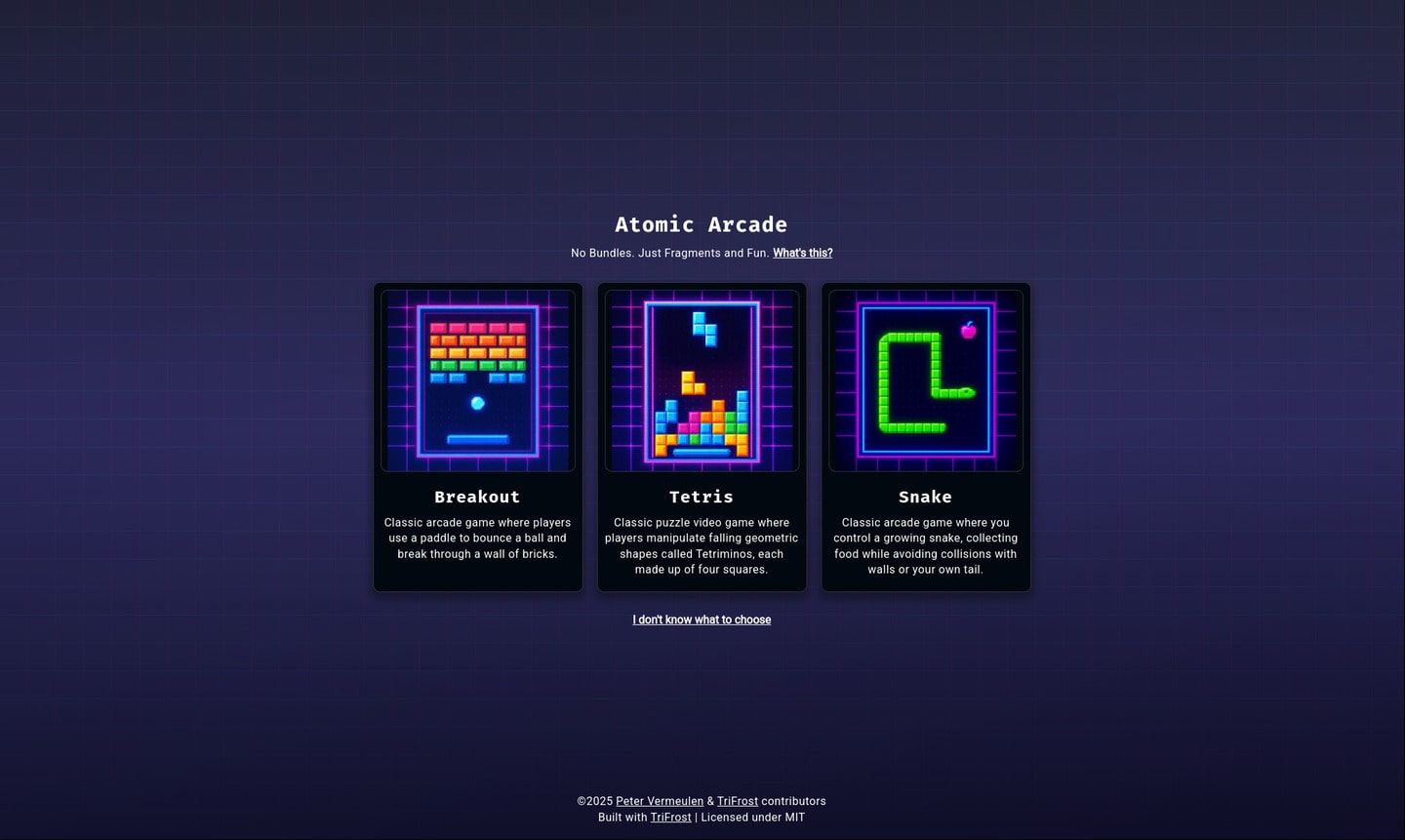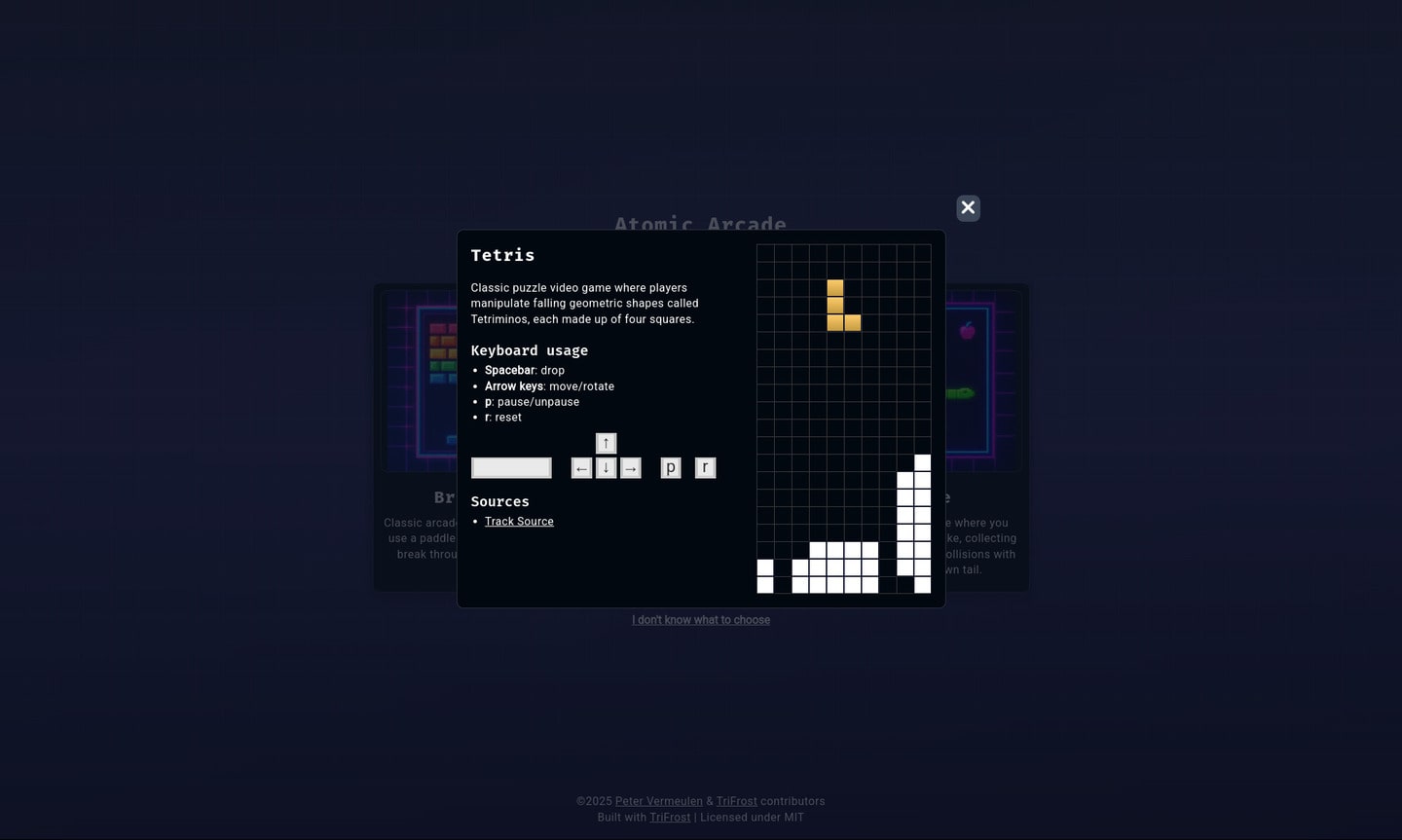Atomic Arcade (TriFrost Atomic)
This example showcases a fully reactive, fragment-rendered arcade experience built with TriFrost Atomic, running entirely on Cloudflare Workers.
No bundlers. No hydration wrappers. Just streaming HTML, scoped styles, and atomic logic — rendered and delivered on demand.
It’s more than just a tech demo — it started as a benchmark for fragment reactivity and evolved into a fully playable arcade with Snake, Tetris, and Breakout. Each game runs in isolation, fragments hydrate independently, and global coordination (modals, audio, theme) happens through scoped relays and shared modules.
Read the full blog post: Atomic Arcade: Fragments In Motion
How It Works
The arcade runs entirely on server-rendered fragments, with zero client bundles. Every interaction, menus, games, themes, is coordinated through <Script> and Module components provided by TriFrost’s Atomic Runtime.
All pages and components are rendered just-in-time using fragments. Style shards and behavior scripts are deduplicated on the fly, making performance and rehydration seamless, no matter how often the DOM updates.
⚡ Atomic Arcade is a bundle-free, streaming-native gaming site. It’s not just fast, it’s a blueprint for fully reactive islands, built server-first.
Project Setup
This project was scaffolded with npm create trifrost@latest, giving us an instant boilerplate with JSX, Atomic, and styling support out of the box.
From there, we customized it with:
- Game logic encapsulated in fragment-aware routes
- Shared layout + atomic styling
- Two global modules for modals and audio
- AtomicRelay pubsub events
- AtomicStore for typed local storage of settings
Structure
atomic-arcade/
├─ src/
│ ├─ components/ # Fragmented game + ui components
│ ├─ routes/ # Game routes/logic (Tetris, Breakout, Snake)
│ ├─ css.ts # Design tokens + definitions
│ ├─ script.ts # Atomic Script + Module system
│ └─ index.ts # Entrypoint
└─ public/ # Assets (audio, images, ...)Why This Matters
TriFrost Atomic was built to push the boundaries of fragment-based reactivity, and Atomic Arcade became the testbed for it.
"I needed something to break. That something became Atomic Arcade."
~ From the Fragments In Motion blog post
Through this project, we tested:
- 💡 Cross-fragment event coordination via AtomicRelay
- 🧩 Dynamic script injection + deduplication
- 🎮 Canvas loops controlled from scoped
<Script>instances - 🔈 Module-based audio control
- 🧹 Scoped cleanup and reactivity lifecycles
Every menu, every pixel of food, every line cleared in Tetris, all of it runs inside an isolated atomic VM, rendered server-side and hydrated only when needed.
Fragment-Based Rendering
Every interaction is powered by fragment rendering, each ctx.html(...) returns only the JSX/scripts/styles you need for that interaction.
- Menus swap in and out as fragments
- Games are mounted on demand with DOM + Canvas logic inside
<Script> - Modals and global state are coordinated with AtomicRelay and AtomicStore
This architecture ensures fast load times, scoped hydration, and safe style/script injection across page changes.
🧩 Want to understand how this works? Read JSX Fragments and Script Behavior
Request Flow & Runtime Wiring
When a request hits the arcade, TriFrost assembles everything just-in-time:
- Styles are auto-sharded based on component usage
<Script>and dependent Modules are injected with CSP-safe hydration- Atomic relay and store are wired up, no global leaks
Here’s what a full request-to-response pipeline looks like:
# 1️⃣ User lands on homepage (`/`)
$ GET /
📦 → /routes/index.tsx
├─ <Home /> JSX
├─ Uses: Modal module + home styles + home scripts
📤 Response includes:
├─ ✅ HTML: Home layout
├─ 🎨 Styles: Only from Home
├─ 🔒 Scripts: Home behaviors
└─ 🧠 Modules: modal (as used in home scripts)
# 2️⃣ User clicks "Snake"
$ GET /snake → ctx.html(<Snake />)
📦 → /routes/snake/routes.tsx
├─ <Snake /> JSX
├─ Uses: Audio module + Snake styles + Snake logic
📤 Response includes:
├─ ✅ HTML: Snake grid, controls
├─ 🎨 Styles: Snake-specific
├─ 🔒 Scripts: Input + Game loop
└─ 🧠 Modules: audio ← modal already mounted, skipped
# 3️⃣ Game begins: food spawns
$ GET /snake/food → ctx.html(<Food />)
📦 → /routes/snake/atoms/Food.tsx
├─ <Food /> JSX
├─ Uses: styles + scripts for interactive food
📤 Response includes:
├─ ✅ HTML: Food node
├─ 🎨 Styles: Food-specific
└─ 🔒 Scripts: Food behavior (e.g. bounce, click)
# 4️⃣ Another food spawns (script already present)
$ GET /snake/food → ctx.html(<Food />)
📦 TriFrost deduplicates:
├─ ✅ HTML: New food
├─ 🎨 Styles: Only new shards (if any)
└─ 🔒 Scripts: ✅ Already hydrated — not resentResponse:
- HTML: Rendered JSX for the response
- Style shards: auto-injected with deduplication
- Scripts: hydrated with CSP nonce, serialized in-place and auto-deduped
- Dependend modules: activated once per page, ready to handle pubsub or relay
💡 Since everything is reactive, no hard coupling exists between routes. Each one can mount/unmount fragments, inject scripts, or trigger global events.
This allows:
- Snake to spawn a
<Script>-hydrated food fragment mid-game - Tetris to control keyboard input and re-render lines dynamically
- Modals to open from any game or route via
$.modal.open(...)(fully typed) - Audio to auto-respond to
$.audio.fx(...)
It’s a runtime-powered graph, with each node living only as long as it’s needed.
Features
- 🕹️ Zero-bundle arcade games: rendered entirely via server fragments
- 🧠 Reactive VM model: every
<Script>node runs inside an isolated lifecycle-aware sandbox - 🧩 Full JSX Fragment pipeline: all updates are streamed, deduped, and nonced
- 🎨 Atomic CSS: scoped definitions and responsive theming
- 📦 App logic and visuals co-located in single JSX files
- 🔊 Audio + modal management: powered by global Module components
- 🌐 Edge Native: Runs entirely on Cloudflare Workers for instant responses
Examples
Want to dive deeper?
- See how Snake uses fragment-based food spawning
- Watch Tetris mount a canvas and control input via
$.on(...) - Observe how the modals automatically extend the Atomic
$utils with$.modal.open(...)and$.modal.close(...)
✅ All styles are auto-collected per fragment
✅ All<Script>instances are isolated, nonced, and hydrated in-place
✅ You won’t find a single bundler or client-side framework
Runtime
This example runs entirely on [Cloudflare Workers](https://developers.cloudflare.com/workers/), optimized for low-latency, global rendering with fragment support baked in.
TriFrost handles:
- ✅ CSP-safe style/script injection
- ✅ Streaming-compatible hydration
- ✅ Lifecycle-scoped modules + VMs
💡 Want to inspect or run the code yourself? It’s open source and intentionally minimal.
No indirection. No framework glue. Just DOM, scripts, and style.
🕹️ Want to learn the story behind it? Read the full blog.
Resources
- TriFrost Atomic Runtime: Per-node reactivity, lifecycle, and pub/sub
- JSX Fragments: Learn how server-rendered fragments work
- JSX Basics: Everything you need to know to build with TriFrost JSX
- Script Behavior: Learn how
<Script>andModulehydrate behavior - CLI Quickstart: Scaffold a new project with npm create trifrost@latest

